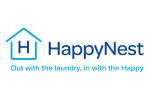OAKBROOK TERRACE, Ill. — Two laundry business operators who offer wash/dry/fold pickup and delivery services described their delivery fleets and addressed some of the challenges involved in maintaining them during a recent Coin Laundry Association webinar.
In “Pickup and Delivery: Managing Your Fleet,” Beck Miller, director of franchise operations for Laundrolab based in Charlotte, North Carolina, and Travis Unema, who owns Brio Laundry in Bellingham, Washington, detailed their respective operations and suggested best practices for acquiring and maintaining the vehicles that their pickup and delivery efforts depend upon.
In Part 1, Miller and Unema detailed some of the inner workings of their individual pickup-and-delivery models, including what factors played a role in their vehicle selections, how the vehicles are outfitted, and the expected maintenance involved. Let’s conclude:
HOW MUCH WILL MAINTENANCE COST?
Unema says that between its two vehicles, Brio spent about $3,000 on maintenance in 2022. This included things like tire replacement, windshield/mirror repair or replacement, and lift-gate work. He says a pickup and delivery service can expect to spend roughly $2,000 per vehicle on annual maintenance: “That’s probably a good number for people to use.”
“Our number isn’t far off from Travis,” Miller says. “Over the course of a year, your vans are getting a lot of mileage on them. Our vans are doing 25,000 miles a year, so you need to do a lot of routine maintenance stuff and those expenses add up. And then especially as you get into the 50,000-plus mile mark, you’re going to have the bigger things that need work done and if they don’t fall under warranty, they’re going to add up. … Occasionally, you have a transmission fail, and it’s out of warranty, and it’s a lot more (expensive) than you anticipated.”
INSURANCE CONSIDERATIONS
Unema says choosing insurance coverage is all about how much liability and coverage you want. Brio spends about $3,000 per vehicle to insure them.
“I don’t really care as much about my van as I do about the people in my van and the other car out there,” he says. “Working with your insurance person, you’re going to have to figure out which plan is right for your vehicle and where you travel. If you’re traveling in high-traffic areas, or an industrial area like an oil refinery, you might want some good insurance in case someone crashes into a pipe or something like that.”
Apart from the vehicle, be sure to check applicants’ driving records to see that you have good drivers before hiring them.
“We’re in the same boat as Travis,” Miller adds. “Our insurance provider checks the licenses when we hire a new driver. We do our own background check but they also run a driver screening.”
Laundrolab’s insurance provider won’t cover any driver who’s younger than 25, he says.
Over time, Miller says the company made a lot of insurance claims for things that it probably shouldn’t have.
“We made claims for a door not working because the vehicle got sideswiped in a parking lot,” he recalls. “There’s little things that, in the grand scheme of things, it would have been better to pay for them out of pocket because our rates went up and then when we launched our service in Florida, it really hurt our ability to get insured there.”
Florida is a no-fault automobile insurance state, which means that drivers must carry personal injury protection insurance to pay for their medical expenses and other accident-related damages, regardless of who caused the collision. The company’s prior claims adversely impacted its rates.
“Be intentional and do the cost-benefit (analysis) on what each of those claims are,” he warns.
Also, remove employees from your insurance coverage as soon as they leave your company.
“Otherwise, if you forget, they’ll build up and you’ll have 50 people sitting on your insurance … and that can affect your rates,” Miller says.
FINDING AND KEEPING GOOD ROUTE DRIVERS
“For drivers, I look for someone who pays attention to detail and looks presentable,” Unema says, adding that Brio drivers are paid $20-23 an hour and can earn additional bonuses for recruiting new clients. “They’re an extension of my company, of my brand and the rest of the people who work here. So, someone who makes eye contact, has a nice smile. We provide them with a uniform, a cell phone, get them the tools they need and the training they need.”
Training should involve everything from basic vehicle operation to loading/unloading to order fulfillment.
Miller says Laundrolab has had success landing drivers that “stick” through referrals: “Your good employees are most likely going to refer other good employees. If you have a problem employee, I would take their referral with a grain of salt.”
A new Laundrolab hire is assigned to mirror an experienced driver. They run a smaller route for several days so that the veteran can take time explaining and demonstrating. Then, they “swap seats,” with the junior driver taking the lead and the vet overseeing their progress.
Drivers are paid between $15 and $20 an hour depending on seniority. Full-time employees have access to healthcare benefits, 401(k) retirement plan, and can earn performance-based bonuses.
Serious driving violations and instances of aggressive driving aren’t tolerated. For example, if they’re in a company van and are clocked doing 70 in a 35-mph zone, “they’re getting fired,” Miller says.
“Your drivers, for the most part, are the extension of your brand,” he says. “That’s probably the only time the customer is going to interact with your brand. That’s super important to us, obeying speed limits, not being an aggressive driver, all those things.”
MISTAKES TO BE AVOIDED
Can you point out a fleet/driver management mistake you’ve made along the way?
“I think I’m going through it now, and it’s not getting rid of a vehicle soon enough,” Unema says. “Just be aware that as a vehicle grows older, your maintenance is going to go up.”
“Take photos at your pickup, at your delivery,” Miller says. “You’re going to always want that proof of what you picked up and what you dropped off.” Otherwise, it’s your word against your customer’s when they claim something is missing.
The Coin Laundry Association frequently offers webinars that cover topics such as marketing, store operations and management, and new investor education. Visit www.coinlaundry.org/events/webinars to learn more.
Miss Part 1? You can read it HERE
Have a question or comment? E-mail our editor Bruce Beggs at [email protected].


















